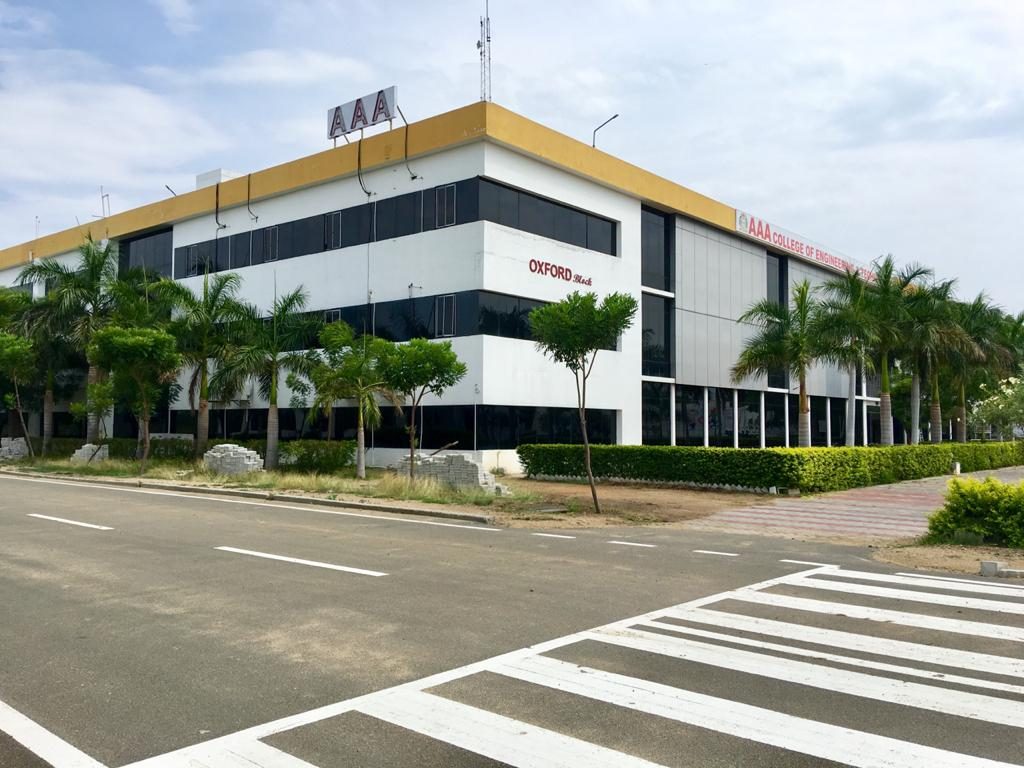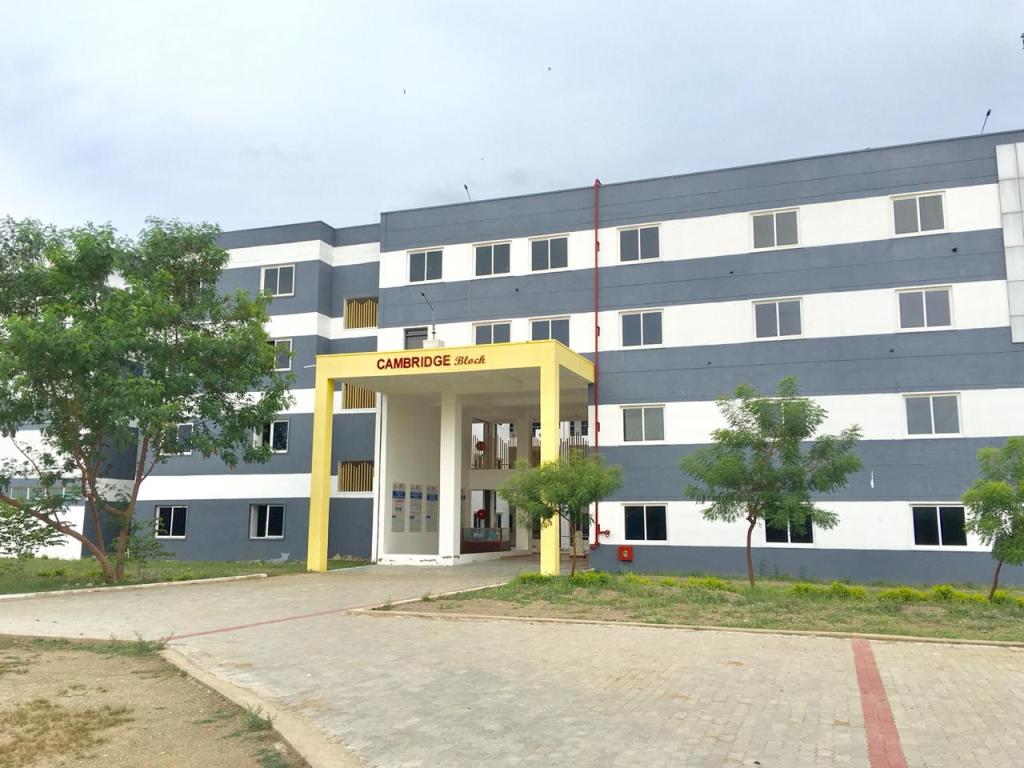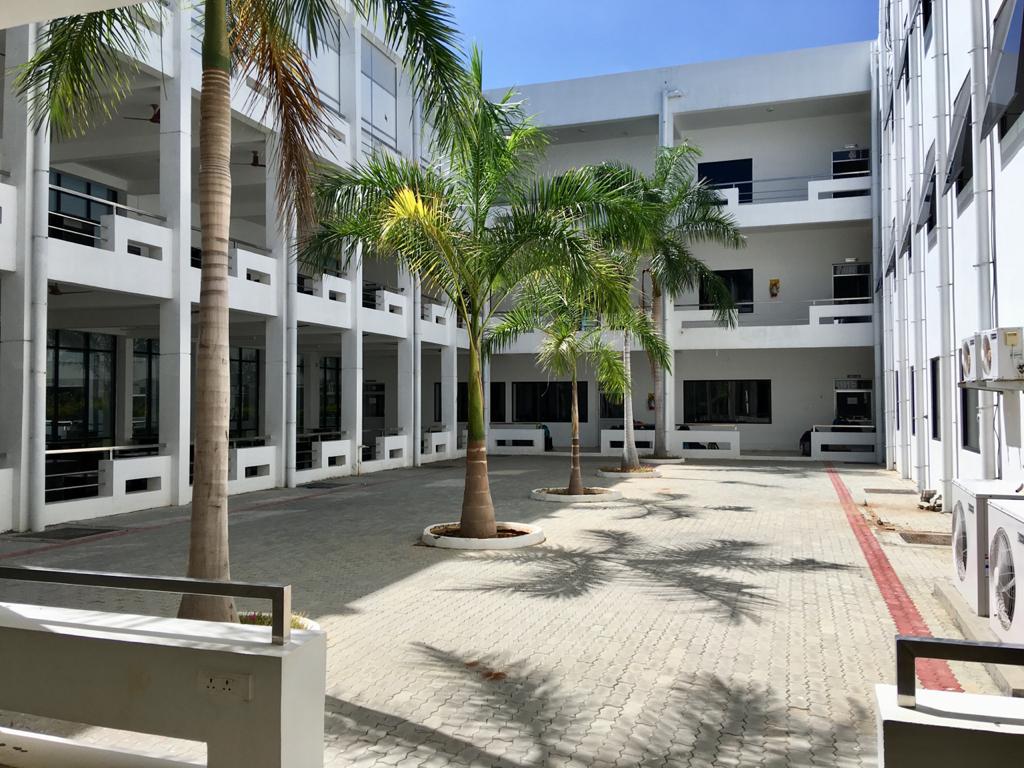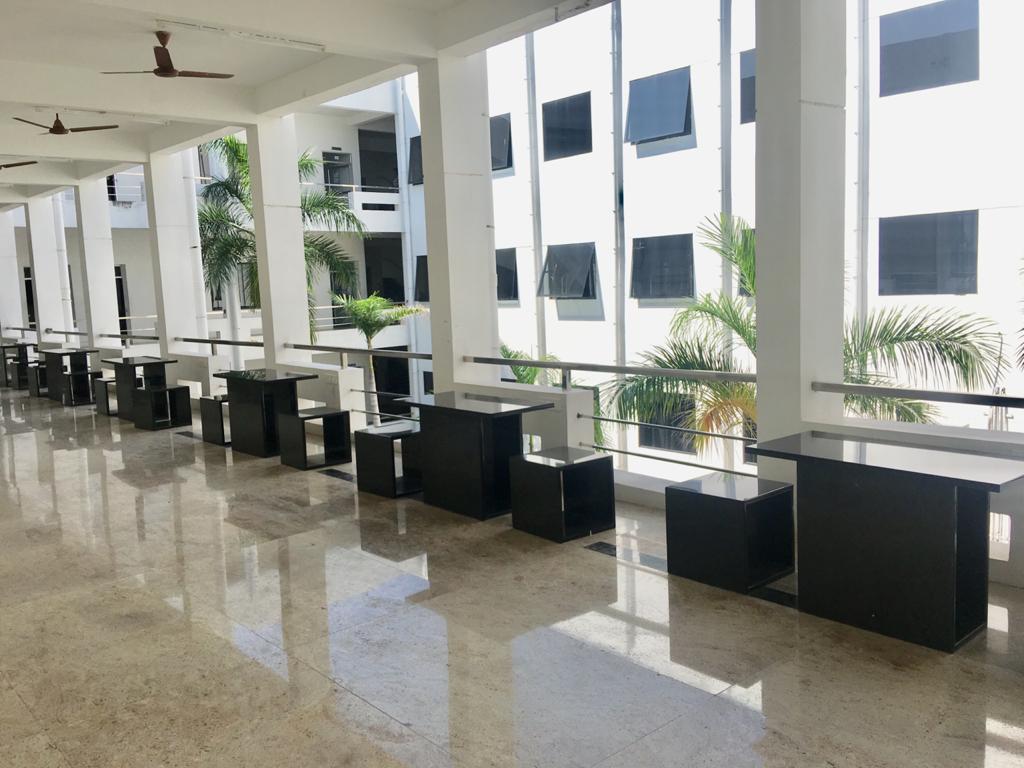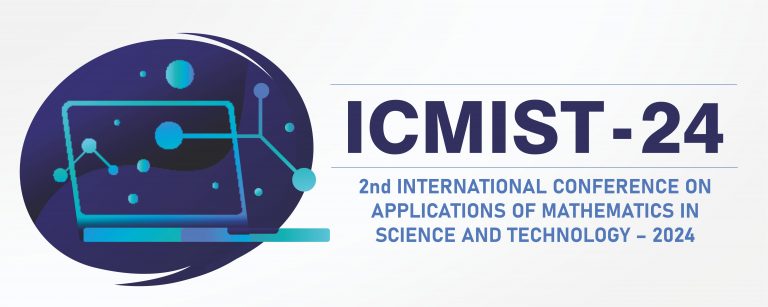2nd INTERNATIONAL CONFERENCE ON APPLICATIONS OF MATHEMATICS IN SCIENCE AND TECHNOLOGY – 2024
(ICMIST – 2024)
21st & 22nd June, 2024
About College
AAA College of Engineering and Technology, Sivakasi was established in the year 2013, is one among the renowned colleges for imparting technical education in the fireworks city. It is branded for its quality education, through Panjurajan Amaravathy trust, Thiruthangal, Virudhunagar District and Promoted by Vinayaga Sony fireworks group of industries. The trust also manages two schools namely, Glory Matriculation Higher Secondary School and AAA International School (CBSE) in Thiruthangal. There by providing quality education right from schooling itself.
AAA College of Engineering and Technology located in the district of Virudhunagar is the one of the youngest institutions accredited with NAAC ‘A’ grade and TUV-ISO 21001: 2018 certification in Tamilnadu. The institution is focused on carrying out research in diversified fields of engineering and was recently granted with the recognition for Ph.D. programme in Mechanical Department by the centre for research, Anna University Research centre. The faculty of AAACET has produced more than 400 papers published in high reputed journals.

About Conference
AAACET invites you to participate in the 2nd International Conference on Applications of Mathematics in Science and Technology (ICMIST-2024) will be held at AAA College of Engineering and Technology, Tamilnadu, India. ICMIST-2024 deals one of the most important problems faced in International development in Pure Mathematics and Applied mathematics development in engineering such as Cryptography, Cyber Security, Network, Operations Research, Heat Equation etc.,
The aim of ICMIST-2024 conference is to provide a platform for researchers, engineers, academicians, as well as industrial professionals, to present their research results and development activities in Pure and Apply Mathematics, and its applied technology. It provides opportunities for the delegates to exchange new ideas and application experiences, to establish business or research relations and to find global partners for future collaboration.
CHIEF GUEST & SPEAKERS

Dr. AYHAN ESI
Malatya Turgut Ozal university,
Dpartment of mathematics,
Turkey.
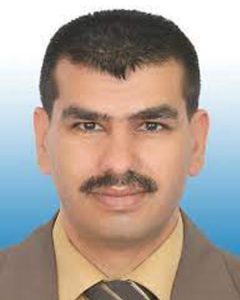
Prof. Wasfi Ahmed Ayid Shatanawi
Director of the General Science Department
Deanship of Educational Services
Prince Sultan University, Saudi.

Prof. Gang Li
Full Professor, Faculty of Sci Eng & Built Env, School of Info Technology,
Melbourne Burwood Campus, Australia

Prof. Akhtar Kalam
Department of Electrical Engineering,
Victoria University, Melbourne,
Australia

Dr. Hüseyin Işık
Assoc. Prof. Hüseyin Işık,
Department of Engineering Science,
Bandırma Onyedi Eylul University, Bandırma, Turkey.

Prof.Dr.Subash Thanappan
Department of Civil Engineering
KAAF University College
Republic of Ghana

Dr.R. Muthuraj
Associate Professor, PG and Research Department of Mathematics,
H.H. The Rajah’s College
Pudukkottai, Tamil Nadu, India.

Dr.S. Azarudeen
Assistant Professor, Department of Statistics and Data Science,
CHRIST University (Deemed to be University)
Bangalore, Karnadaka, India.
CHIEF PATRONS
- Dr. P. Karvannan, Secretary
- Dr. P. Ganesan, Correspondent
- Dr. K. Vignesh Kumar, Joint Secretary
PATRON
- Dr.M.Sekar, M.E., Ph.D., FIE., Principal
CONVENER
- Dr.M.Sekar, M.E., Ph.D., FIE., Principal
CO-CONVENERS
- Dr.J. Hemalatha, Professor & HoD, Dept. of CSE, AAACET
- Dr.R. Senthil Kumar, Associate Professor, Dept. of S&H, AAACET
INTERNAL ADVISORY COMMITTEE
- Dr.S. Krishnapriya, Professor & HoD, Dept. of ECE, AAACET
- Dr.T. Senthil, Professor & HoD, Dept. of ECE, AAACET
- Dr.C. Senthil Kumar, Professor & HoD, Dept. of EEE, AAACET
- Dr.R. Selvabharathi, Professor & HoD, Dept. of Mech, AAACET
- Dr.J. Dharmaraja, Professor & HoD, Dept. of S&H, AAACET
- Dr.P. Elamparithi, Associate Prof. & HoD (i/c), Dept. of AIDS/IT/CS(Cyber)
- Dr.K. Anand, Assistant Professor, Dept. of S&H, AAACET
ORGANIZING COMMITTEE
- Mr.R. Muthu Eshwaran, Assistant Professor, Dept. of CSE, AAACET
- Mrs.G. Gurulakshmi, Assistant Professor, Dept. of CSE, AAACET
- Mrs.S. Rajathi, Assistant Professor, Dept. of CSE, AAACET
- Mrs.D. Grace Jothi, Assistant Professor, Dept. of CSE, AAACET
- Mr.P. Samayan, Assistant Professor, Dept. of CSE, AAACET
- Mrs. Sabeena Burvin, Assistant Professor, Dept. of CSE, AAACET
- Mr.R. Srinivasan, Assistant Professor, Dept. of CSE, AAACET
- Mrs.R. Subitha, Assistant Professor, Dept. of CSE, AAACET
- Mrs.S. Rajeshwari, Assistant Professor, Dept. of CSE, AAACET
- Mrs.K. Padmapriya, Assistant Professor, Dept. of ECE, AAACET
- Dr.S. Suganya, Associate Professor, Dept. of EEE, AAACET
- Mr.Kalyana Sundaram, Assistant Professor, Dept. of EEE, AAACET
- Mrs.V. Chandra, Assistant Professor, Dept. of EEE, AAACET
- Mr.P. Manikandan, Assistant Professor, Dept. of EEE, AAACET
- Mr.P. Nirmal, Assistant Professor, Dept. of EEE, AAACET
- Dr.P.S.R. Senthil Maharaj, Assistant Professor (SG), Dept. of Mech, AAACET
- Dr.M. Balamurugan, Assistant Professor, Dept. of S&H, AAACET
- Mr.E. Kalidass, Assistant Professor, Dept. of S&H, AAACET
- Ms.S. Suguna, Assistant Professor, Dept. of S&H, AAACET
- Dr.A. Shanmugapriya, Assistant Professor, Dept. of S&H, AAACET
- Mrs.S. Gajalakshmi, Assistant Professor, Dept. of S&H, AAACET
- Dr.V. Anushiya, Assistant Professor, Dept. of S&H, AAACET
- Mrs.A. Gajalakshmi, Assistant Professor, Placement Cell, AAACET
INTERNATIONAL ADVISORY COMMITTEE
- Prof. Dr.Mustafa M. Matalgah, University of Mississippi, US.
- Prof. Dr.Husam Jasim Mohammed, Imam Ja’afar Al-Sadiq University, Baghdad, Iraq.
- Prof. Dr.Bilal Alhayani, Yildiz Technical University, Istanbul, Turkey.
- Prof. Dr.Abdallah Abdallah, Dept. of Manufacturing, The German Jordanian University, Jordan.
NATIONAL ADVISORY COMMITTEE
- Dr.B.V.Manikandan, Professor, Mepco Schlenk Engg. College, Sivakasi.
- Dr.S.Kannan, Professor & Head, Dept. of EEE, Ramco Institute of Technology, Rajapalayam.
- Dr. Jeyaraman, Raja Durai Singam College, Sivagangai
- Dr. Muthuraj, HH The Raja’s college, Tamilnadu
- Dr. Nagarajan, Head and professor, PSNACET, Dindigul.
EDITORIAL BOARD MEMBERS
- Dr. Huseyin Işık, Assoc. Prof. Hüseyin Işık, Department of Engineering Science, Bandırma Onyedi Eylul University, Bandırma, Turkey
- Prof.Gang Li, Full Professor, Faculty of Sci. Engg. & Built Env, School of Info Technology, Melbourne Burwood Campus, Australia
- Prof.Akhtar Kalam, Department of Electrical Engineering, Victoria University, Melbourne, Australia
- Dr. M. Jeyaraman, Associate Professor, PG and Research Department of Mathematics, Raja Doraisingam Govt. Arts College, Sivagangai
- Dr.M. Sekar, Principal, AAA College of Engineering & Technology, Sivakasi, Tamil Nadu
- Dr.J. Hemalatha, Professor & HoD, Dept. of CSE, AAA College of Engineering & Technology, Sivakasi, Tamil Nadu
- Dr.R. Senthil Kumar, Associate Professor, Dept. of S&H, AAA College of Engineering & Technology, Sivakasi, Tamil Nadu
- Dr.V. Vivek, Associate Professor, Dept. of CSE, AAA College of Engineering & Technology, Sivakasi, Tamil Nadu
Review Process for ICMIST-24
Double-Blind Peer Review
- To ensure impartiality and maintain the highest standards of quality, ICMIST-24 employs a double-blind peer review process. This means that both the reviewers and authors remain anonymous throughout the review process.
Detailed Review Process
Submission:
- Authors submit their manuscripts through the conference submission system, ensuring that no identifying information is included in the manuscript itself to maintain anonymity.
Initial Check:
- The conference organizers conduct an initial check to ensure that the submission adheres to the conference’s formatting and submission guidelines.
- Submissions that do not comply with the guidelines may be returned to authors for correction before being sent for review.
Plagiarism Check:
- All submissions undergo a plagiarism check to ensure originality. The acceptable plagiarism rate is between 10-15%. Manuscripts exceeding this threshold will be returned to authors for revision or rejected.
Assignment to Reviewers:
- Manuscripts passing the initial check and plagiarism screening are assigned to at least two independent reviewers with expertise in the relevant field.
Review Phase:
- Reviewers evaluate the manuscript based on its originality, technical quality, relevance to the conference topics, clarity of presentation, and significance of the research.
- Reviewers provide detailed feedback and recommendations for acceptance, minor revisions, major revisions, or rejection.
Decision:
- Based on the reviewers’ feedback, the conference program committee makes a decision on each manuscript.
- Decisions can be one of the following: Accept, Accept with Minor Revisions, Accept with Major Revisions, or Reject.
Notification:
- Authors are notified of the decision along with the reviewers’ comments and recommendations.
If revisions are required, authors are given a deadline to resubmit their revised manuscript.
Final Acceptance:
- Revised manuscripts are reviewed again (if necessary) to ensure all reviewer comments have been addressed satisfactorily.
- The final decision on acceptance is made, and authors are notified.
Publication:
- Accepted papers are included in the conference proceedings and scheduled for presentation during the conference.
Transparency and Availability
- Detailed information about the review process is available on the ICMIST-24 website. Authors are encouraged to review this information prior to submission to ensure understanding of the review procedures and expectations.
Guidelines for Authors
- Same authors submit not more than 2 Research articles.
- Papers are good quality and original research articles.
However, we strongly recommend that you write concisely and stick to the following guidelines:
- Articles should ideally be no more than 10 typeset pages.
- The main text should be no more than 4,500 words.
- The title should be no more than 20 words.
- The abstract should be no more than 200 words.
- References not more than 20, self-citations maximum 4.
List of Scopus indexed Publications (For Publication)
- CRC Press – Taylor and Francis (SCOPUS)
- Conference Proceedings (With ISBN)
*** Note: All the accepted papers will be published in Scopus indexed journals after the Conference ***
Call for Papers
1. Differential Equations
2. Control and Dynamical Systems
3. Numerical Analysis
4. Scientific Computing
5. Mathematical Modeling
6. Fluid Mechanics
7. Mathematical Biology
8. Artificial Intelligence & Machine Learning
9. Image Processing
10. Optimization & Operations Research
11. Operator Theory & Approximation Theory
12. Probability & Statistics
13. Fractional Calculus and Its Applications
Submission of Papers
Send your full papers in.doc/.docx to: [email protected]
(Kindly take the given paper template from the website and compose your article using it)
Authors are requested to refer the attached paper format Click Here for format
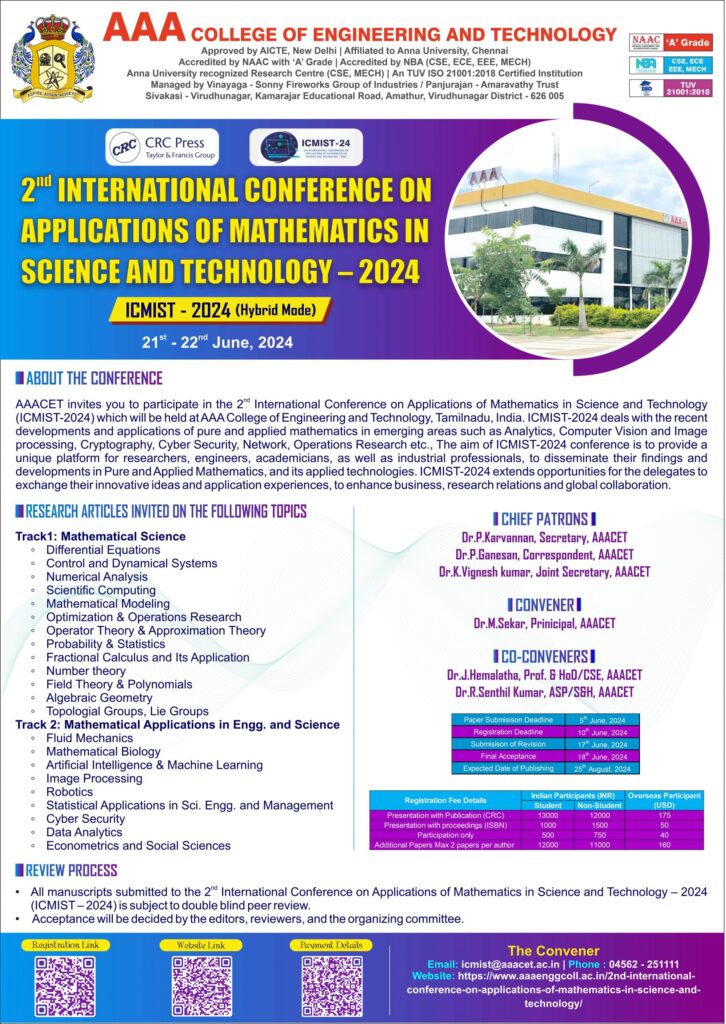
IMPORTANT DATES
| Paper submission deadline (Abstract) | 5th June, 2024 |
| Registration Deadline | 10th June, 2024 |
| Submission of Full Length Paper | 12th June, 2024 |
| First report to authors | 14th June, 2024 |
| Submission of Revision Deadline | 17th June, 2024 |
| Final acceptance to authors | 18th June, 2024 |
| Camera ready submission deadline | 19th June, 2024 |
| Expected Date for Publishing | 25th August, 2024 |
REGISTRATION & PUBLICATIONS FEE (With Scopus Publication)
| Registration Fee Details | India participant (INR) | Overseas Participant (USD) | |
| Student | Non Student | ||
| Presentation with Publication (CRC) | 13000 | 12,000 | 175 USD |
| Presentation with Proceedings (ISBN) | 1000 | 1500 | 50 USD |
| Participants only | 500 | 750 | 40 USD |
| Additional papers Maximum 2 papers per authour | 12000 | 11000 | 160 USD |
We expect research Articles from overseas. We offer a 50% discount on publication fees for the first 20 selected articles from overseas. Demand draft drawn in favor of “The Principal, AAA College of Engineering and Technology” payable at Sivakasi.
Net Banking Payment Details
A/C NAME : AAA COLLEGE OF ENGINEERING & TECHNOLOGY
A/C NUMBER: 33056303234
BRANCH NAME : SME SBI, Sivakasi
IFS CODE : SBIN0018316
INTERNATIONAL CONFERENCE 1:TNSCST SPONSORED INTERNATIONAL CONFERENCE ON APPLICATIONS OF MATHEMATICS IN SCIENCE & TECHNOLOGYDates: 25th & 26th July, 2019 |
https://aaaenggcoll.ac.in/tnscst-sponsored-conference/ |
INTERNATIONAL CONFERENCE 2:INTERNATIONAL CONFERENCE ON RECENT INNOVATIONS IN COMPUTER, COMMUNICATION AND MANUFACTURINGDates: 12th & 13th April, 2023 |
https://aaaenggcoll.ac.in/icriccm-2023/ |
INTERNATIONAL CONFERENCE 3:INTERNATIONAL CONFERENCE ON ENVIRONMENTAL DEVELOPMENT USING COMPUTER SCIENCE – 2024Dates: 11th & 12th January, 2024 |
https://www.aaaenggcoll.ac.in/icecs24/ |
PUBLISHED PAPER
| Title | Applications of Mathematics in Science and Technology |
| Editors | Bui Thanh Hung, M Sekar, Ayhan Esİ, R Senthil Kumar |
| Publisher | CRC Press, 2025 |
| ISBN | 1032999055, 9781032999050 |
| Length | 1058 pages |
| Subjects | Mathematics General Mathematics / General |
EDITOR(S)
Bui Thanh Hung, Data Science Department, Faculty of Information Technology, Industrial University, Ho Chi Minh City, Vietnam. He has published 35 research articles scopus indexed books and 30 book chapters 46 international conference, 21 national conference, 123 journals reviewers for special issue. He delivered 47 Invited tals, organizing 2 international conferences.
M. Sekar, a well-known academician has taken charge as Principal of AAA college of Engineering and Technology, Sivakasi, Tamilnadu, India since July 2018. He brings his wide and rich administrative, industrial, research and international exposure to achieve the vision and build institutions.
Ayhan ESİ is currently working as a Professor in Malatya Turgut Ozal University, Yeşilyurt, Malatya, Turkey. His research interests include Summability Theory, Sequences and Series in Analysis and Functional Analysis.
R. Senthil Kumar is an Associate Professor in Science and Humanities, AAA College of Engineering and Technology, Sivakasi, Tamilnadu, India. His areas of interest are Mathematics, Network Theory, Enterprise Resource Planning, Analytics, Information Technology and Statistical Packages.
Table Of Contents
1. “Smart Village” Concept in Karabagh and Eastern Zangazur Economic Regions
2. Designing an Efficient and Scalable Oracle Database: Best Practices and Methodology
3. Graphical Representation of Human Development Index
4. Computer Network Design Problem
5. Application of Internet of Things (IOT) Technology in Smart Cities
6. Comprehensive Analysis of Diabetic Retinopathy Identification Using Deep Learning and Machine Learning Techniques
7. Research security issues in VPN technology
8. Hydrostatic pressure of a heterogeneous fluid, and the relationship between stationary and
non-stationary viscosity coefficient of liquids
9. An efficient power denso-optimized TRN generator by using clock gating and reconfigurable oscillators
10. Using information technologies in teaching mathematics
11. The rise of automated information search systems
12. Artificial intelligence (AI) in civil engineering and Tekla structures
13. Development of the electronic government concept: The experience of the Republic of Azerbaijan
14. New methods and applications in practice, quality, and scalable of database created using Oracle
15. Investments in Azerbaijan’s electricity sector: Equilibrium price and marginal cost function
16. Strategies for the efficient use of Azerbaijan’s oil and gas resources
17. Features of digital employment in the Republic of Uzbekistan
18. Environmental aspects of the transport sector
19. Detection and Classification of Abnormal Events from Surveillance Video using Random Forest
Algorithm and Compare the Accuracy with Decision Tree Algorithm
20. A productive utilization of investments allocated to the Silk Road’s rebuilding
21. Green economy: How did COVID-19 affect the sustainable practices of Hilton Worldwide
and Marriott International?
22. Problems of transition to a green economy
23. Production of biohydrogen from hydrothermal pretreated green algae and comparison with
Laminaria digitata
24. Application perspectives of priority digital tools in ensuring sustainable macroeconomic balance of the insurance segment
25. Evaluation of customs-tariff regulation in Azerbaijan’s container transport system and its impact on the environment
26. Externalities in the era of digitalization: Strategies for public internalization and sustainable revenue generation for structural transformation
27. Different approaches to the study of the category “Human capital” and analysis of its quantitative assessment
28. Priority solutions to problems of regulation of financial markets
29. Main directions of associative activity of Azerbaijan with world countries
30. State finance: The role of digital tax calculations in macroeconomics of Azerbaijan
31. The place of the concept of holistic tourism in domestic and foreign literature: A document analysis
32. A qualitative study on the influence of tourists on the formation of restaurant menu content
33. Design and analysis of lumped port perpendicular shape antenna directivity for 5G signal transmission in compare with W shape
34. An essential hybrid model for developing fuzzy rules in a specific malware identification and
detection system
35. Malicious transaction detection in Internet of Things networks using the Moth Blade Optimization and K Nearest Neighbor algorithms
36. An assessment on the utilization of machine learning for AI-driven fault identification in the industrial internet of things
37. An elegant and visually appealing way to enhance cutting-edge AI-driven simulated intelligence for the ever-changing e-commerce industry
38. A secured and safer digital malware classification using an enhanced and efficient deep learning-based approach
39. An assessment of the machine learning technique’s design metrics for creating search engines
40. Examining the emerging threat of Phishing and DDoS attacks using Machine Learning models
41. Analysis on an enhanced safe and secured intrusion detection system with a machine learning
methodology
42. Robust lasb-based modified data stenography methods for large size content hiding capability
43. Proposed methods for evaluating shape-based identification techniques for identifying numbers using CNN
44. Tuberculosis identification and detection application using deep learning—cloud based web
45. An assessment on evaluation of image encryption techniques for practical applications in reliable multimedia applications
46. An innovative approach for classifying industrial components by integrating machine learning and image processing techniques
47. A rapid development in the banking industry for convolutional neural network-based signature
verification
48. Recognition and endorsement of enhanced privacy preservation in cloud computing through the RPSM method
49. An IoT-based, two-tier comprehensive and affordable intrusion detection system for smart home security
50. An innovative method for information security that makes use of RC4 and LSB techniques
51. Developing and implementing cryptography and steganography to secure data for data hiding in images
52. Exploring video-based question processing by using graph transformation and complementing
approach
53. Employing an innovative machine learning regression methods for cotton leaf disease detection
54. A dynamic data hiding method to encrypt cipher text for security-based image processing
55. Employing RSA based encryption by demonstrating a faster secured data system using Hadoop
distributed file system
56. A novel method for minimizing IoT network-based mobile edge cloud computing with big data analytics
57. An examination of the big data-based security solution for safeguarding the virtualized environment in cloud computing
58. Lightweight cryptography and multifactor authorization are used to design and evaluate a large-scale data Internet of Things system that is secure and scalable
59. Analysis on the deduplication of protected data using enhanced elliptical cryptography, load balancing, and associated support
60. A comparative study on the efficiency of machine learning techniques for recognizing malaria symptoms using microscopically image data
61. AI-driven cloud framework for IoT devices: Implementation and localization in indoor environment
62. SVM and MLP-based optimized resource allotment simulation and demonstrations for load balancing
63. A fundamental deep learning algorithm-based system for hidden images in steganography
64. A new algorithm for deducing user search intensities from feedback sessions
65. Android-based sign language conversion using message service system
66. Bioinformatics of athletes to record the cardiovascular issues through using KNN algorithm
67. IMBP-EDT: Intelligent multi HOP broadcast protocol for emergency data transmission services
68. Protocol models in emergency data transmission services: A survey
69. A study on business intelligence and its comparison with business analytics
70. IOT based smart blind stick using ultrasonic sensor
71. Job portal with chatbot using NLP with socket
72. Levying and anticipate of a structural project using our in-depth analysis process
73. Sales prediction using machine learning algorithms
74. Sustainable diligent blockchain for conventional storage
75. The authenticated key exchange protocols for resemblant network train systems
76. A study of the privacy and security implications of Ip geolocation, including potential risks to
individuals and organizations
77. Course material distribution system
78. Cyber forensics techniques for investigating cyber espionage attacks
79. Data aggregation method for wireless sensor networks to isolate an node
80. Detecting cyber defamation in social network using machine learning
81. Development of lung cancer detection using machine learning in a computer-aided diagnostic (CAD) system
82. Evaluating the effectiveness of ChatGPT in language translation and cross-lingual communication
83. Investigation of transfer learning for plant disease detection across different plant species
84. IOT based attendance system for schools and colleges using RFID reader
85. IoT based energy management using bidirectional visitor counter technique
86. Online shopping using Javascript
87. Social media network using socket Io algorithm
88. Erythrosine dye decolorization by sonolysis and its performance evaluation under varying pH conditions of thiazine dye
89. Synthesis and characterization of silver nanoparticles using listed novel essential oils for its anti-inflammatory efficiency in comparison with Diclofenac drug
90. Deep learning based Alzheimer’s diseases identifier
91. Augmented reality analytics visualization engine
92. Data plugin detection and prevention technique on SQL injection attacks
93. Migration of employee database with data integrity using novel trickle approach compared over
replatforming technique in cloud
94. Design and comparison of RF analyses of an innovative SSE structure microstrip aerial using FR4 and arlon AD300A materials for S-band applications
95. Detecting the accurate moving objects in indoor stadium using you only look once algorithm compared with ResNet50
96. Improved accuracy in automatic deduction of cyberbullying using recurrent neural network and
compare accuracy with AdaBoost classification
97. Prediction of share market stock price using long short-term memory and compare accuracy with Gaussian algorithm
98. Accurate resume shortlisting using multi keyword scoring technique in comparison with K-nearest neighbor algorithm
99. An effective approach for prediction of sensors uncertainty in agriculture using maxima algorithm over linear regression algorithm
100. Comparison of accuracy for rapid automatic keyword extraction algorithm with term frequency
inverse document frequency to recast giant text into charts
101. An effective approach to accurately recast giant text using rapid automatic keyword extraction
algorithm in comparison with collaborative filtering algorithm
102. Comparison of accuracy for novel optical character recognition technique over K-nearest neighbor algorithm to extract text from image and video
103. Access time computation for malicious application prediction using you only look once V3-spatial pyramid pooling over single shot detector
104. Analysis of vehicle theft detection and enable alert signal using Novel ResNet-50 compared and Lasso regression with improved accuracy
105. Detection of cervical spine fracture using DenseNet121 and accuracy comparison with convolutional neural network
106. Recognition of masked face using Visual Geometry Group (VGG-16) algorithm in comparison with Long Short Term Memory (LSTM) algorithm for better detection
107. Recognizing and removal of hate speech from social media using Google Net Classifier in comparison with Bayesian Regression for improved accuracy
108. Elevating and protecting security for personal health records in cloud storage using tripledes compared over AES with better accuracy
109. A novel logistic regression algorithm compared with the random forest algorithm to improve the accuracy of predicting crashes in automated driving system cars
110. Analysis of machine learning techniques for moisture prediction using random forest and logistic regression to improve accuracy
111. A comparative analysis of the question and answer capabilities with the BERT token model algorithm compared with the Novel Roberta token model algorithm for improved accuracy
112. Efficient prediction of man-in-middle-attack in IOT device using Novel Convolutional Neural Network compared with Google Net with improved accuracy
113. Accuracy of comparing the effectiveness of AlexNet and support vector machine in predicting PCOD in women
114. Prediction of accuracy for highest bid of products in online auction system using support vector machine in comparison with K-means clustering
115. Forecasting sales for big mart using NovelXGBoost algorithm in comparison of accuracy with linear regression
116. Analysis of restaurant reviews using novel hybrid approach algorithm over support vector machine algorithm with improved accuracy
117. Effective prediction of IPL outcome matches to improve accuracy using novel random forest algorithm compared over logistic regression
118. To contrast novel random forest algorithm over gradient boosting classifier algorithm to improve accuracy in predicting the IPL outcome matches
119. Comparison of hybrid regression model with smoothed moving average model for demand forecasting of product
120. Comparison of improved XGBoost algorithm with random forest regression to determine
the prediction of the mobile price
121. Efficient of cursive character recognition in IOT using CNN compared with ANN with improved
accuracy
122. An efficient treatment for cherry tree disease using the random forest classifier comparison with the decision tree algorithm
123. Detecting aquatic debris on ocean surfaces using AlexNet algorithm compared with the GoogleNet algorithm
124. Determining the accuracy in examining the human lifespan by using Novel K-Nearest neighbor algorithm comparing with RIPPER algorithm
125. A comparative analysis of the performance of XGBoost and the gradient boosting for predicting sales at large supermarkets
126. Analysis of a recurrent time delay neural network and Gaussian Naive-Bayes algorithms for effective flood prediction techniques using accuracy
127. Detection of player movements in indoor stadium using you only look once algorithm compared with GoogleNet algorithm
128. An innovative multiauthority attribute based signcryption using advanced encryption standard algorithm comparing with Fernet algorithm to enhance accuracy
129. Prediction of locational electricity marginal prices with improved accuracy by using the Lasso
algorithm over linear regression algorithm
130. Comparison of accuracy using novel artificial neural network model over logistic regression approach for flood prediction
131. Blind face image restoration using novel generative adversarial network V3 in comparison with deep face dictionary network to improve naturalness image quality evaluator score
132. Comparison of generative adversarial network v3 with Gan Prior Embedded Network in blind face image restoration to improve naturalness image quality evaluator score
133. Improving execution rate in cloud task scheduling using Novel Hybrid Genetic algorithm over
optimization scheduling algorithm
134. Enhanced speed bump detection system for driver assistance system (DAS) using Otsu’s threshold over adaptive Gaussian threshold for higher accuracy
135. Automatic masked face recognition and detection using recurrent neural network compared with linear discriminant analysis to enhance accuracy
136. Enhancing accuracy in predicting forgery analysis on basis of fake reviews in comparison of in
E-commerce platform by comparison of novel multilayer perceptron over random forest algorithm
137. Determining the enhancement of fake reviews by comparing novel MultiLayer perceptron and gradient boosting algorithm in predicting forgery analysis in E-commerce application
138. Accurate usage analysis of a specific product based on Twitter user comments using random tree algorithm compared with AdaboostM1 algorithm
139. Enhancing accuracy of innovative topic modeling of cinema reviews in Twitter data through Latent Dirichlet Allocation in comparing non-negative matrix factorization
140. Improving the accuracy of cinema review topic modeling on Twitter with parallel latent Dirichlet allocation and latent Dirichlet allocation
141. Modeling and analysis of the return loss and gain performances of innovative meander-loaded
triangular antenna and OCSRR-embedded triangular antenna for low-frequency applications
142. Braille character recognition for blind people using MobileNet compared with LSTM model
143. ILS: Robust design of artificial intelligence assisted diabetic retinopathy prediction using improved learning scheme
144. Improved artificial intelligence oriented deep learning based melanoma detection scheme with advanced prediction principle
145. A study on flexible behavior of ultra-high-performance fiber-reinforced concrete composite panels
146. A comprehensive approach to image cartoonization using edge detection and morphological
operations
147. User based E-commerce feature prediction using RNN
148. Leveraging recurrent neural networks and capsule networks for time-series forecasting with
multi-source data fusion
149. Investigation of seismic performance of reinforced concrete shear walls
150. Leveraging AI and blockchain in MANETs to enhance smart City infrastructure and autonomous
vehicular networks
151. Developing a chatbot using an ensemble of deep learning and neural networks
152. Optimizing agricultural water management through IoT-enabled smart irrigation system
153. An examination of the process of creating a fault-tolerant resource scheduling approach for a cloud environment
154. Design and implementation of a sensor-integrated IOT system for enhanced crop monitoring and management
155. Integrating machine learning and data lakes for improving predictive maintenance and industrial IoT applications
156. Deploying cloud computing and data warehousing to optimize supply chain management and retail analytics
157. Comparative toxicity of herbal extracts of Terminalia chebula Retz. and chemical pesticide cypermethrin against aquatic mosquito predators
158. Advanced crop recommendation using firefly algorithm with fuzzy weighted convolutional neural network: A hybrid algorithmic solution
159. Hyperparameter-tuned Alexnet for automatic classification of medicinal plant leaves using enhanced fuzzy possibilistic C-means clustering
160. Analyzing the performance of the three-phase inverter using SVPWM technique
161. Enhanced data security and privacy in healthcare using a new secentralized blockchain architecture
162. Study of THD reduction in voltage source inverter with PI controller against variation in loads and unexpected input
163. A prototype of solar powered smart dustbin
164. Enhanced performance of photovoltaic systems with LUO converter and modified P and O tracking algorithm
165. A prototype of an automatic baby cradle powered by solar energy
166. Green sea ports—A futuristic idea
167. Space allocation monitoring based on sensors
168. Real-time sag detection and line stand fall protection for overhead transmission lines
169. Enhancing load frequency control in interconnected power systems using PSO-tuned PI controller
170. Strategies and policies for sustainable natural energy resource management
171. Comparative in silico analysis of peroxidase gene family present in arabidopsis, rice, poplar and orange plants
172. Representation of entrepreneurs success and failure in a sustainable energy sector: A case study
173. Evaluation of friction stir welds by ultrasonic inspection technique for Al 7075 and Al 7068
174. Numerical and non-destructive analysis of an aluminum-CFRP hybrid 3D structure
175. Academic transition towards digital architecture in Papua New Guinea
176. PNG defence force officially introduced force 2030 doctrine as a pivotal component of its forthcoming strategic framework
177. Investigating the root cause of high-water consumption in bottle washing equipment: A case study
178. Investigation of Absent Imprints in Laser Date Coding for Cans
179. Experiment on the impact of resin matrix under static and fatigue stress in basalt fiber reinforced polymer composites
180. Characterization of polymer ceramic composite materials for orthopedic applications
181. Experimental study on ultra-high-performance fibre reinforced concrete beams
182. Optimizing CNN architecture for facial emotion recognition: Experimental evaluation and parameter tuning
183. Computational screening of the lead compounds for obesity by targeting human FTO mutant E234P with various ligand library using in-silico approach
184. Optimal approach to enhance accuracy in detection of acral lentiginous melanoma by random forest and in comparison with Naïve Bayes algorithm
185. Analyzing security vulnerabilities in consumer IOT applications using Twofish encryption algorithms comparing with DES algorithm
186. Bacterial lipase enzyme production by Bacillus licheniformis MTCC8725 in solid-state fermentation by comparison of coconut oil and olive oil as substrates
187. Comparison of biogas production from the anaerobic treatment of Cauliflower stem with Cow dung in biodigester
188. Comparison of biogas production from the anaerobic treatment of corn starch waste with cow dung in the biodigester
189. Cr(VI) removal from simulated wastewater using HCl modified biochar of Wodyetia bifurcata seeds in comparison with commercial activated carbon
190. Comparative analysis of sonolysis performance in demineralizing ammonium lauryl sulfate for
sustainable environment against cetyl alcohol
191. Performance evaluation of sonolysis in demineralizing toxic cetyl alcohol under standard conditions against sodium laureth sulfate for sustainable environment
192. Production of biobutanol from pre-treated Syzygium cumini and comparison with sugarcane straw
193. Comparison of biogas production from the anaerobic treatment of animal waste with cow dung in the biodigester
194. Production and characterization of saw dust briquettes from Azadirachta indica using rice husk as binder in comparison with Melicia Elcelsa
*** Please wait for the update ***
REACH US
Co-Convenor
Dr.R.Senthil Kumar
E-mail: [email protected]
Mobile No: 9791627583
Phone No: 04562 – 251111

